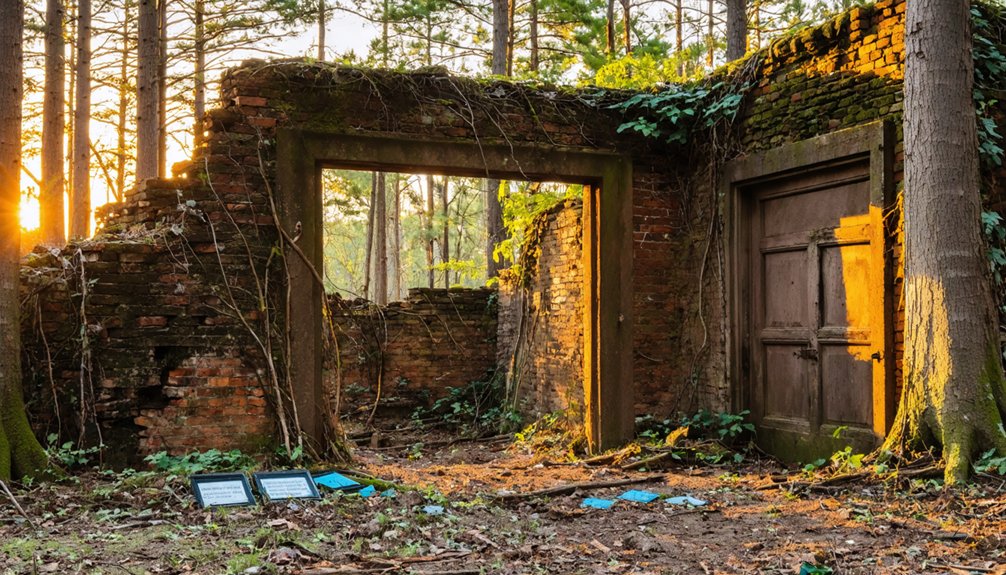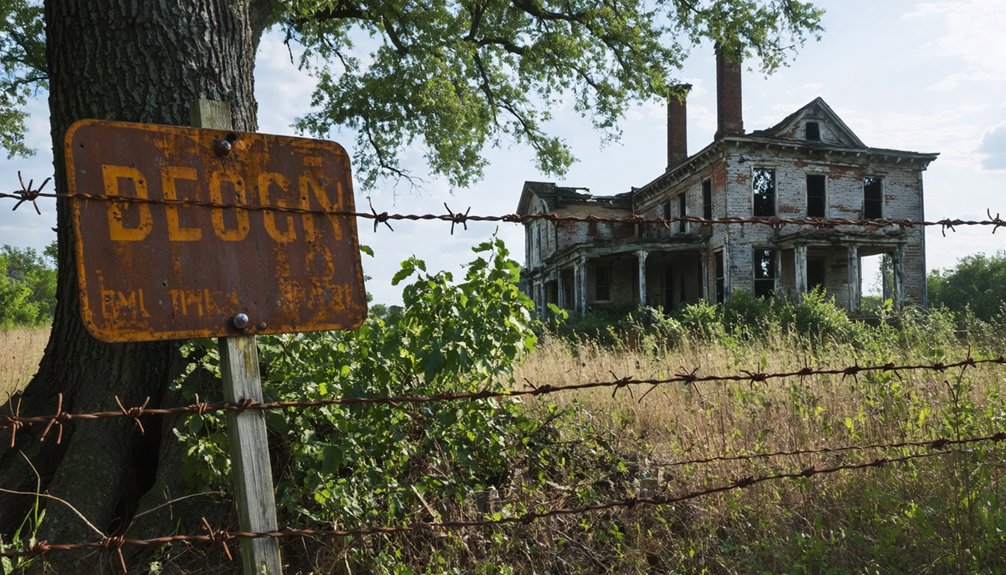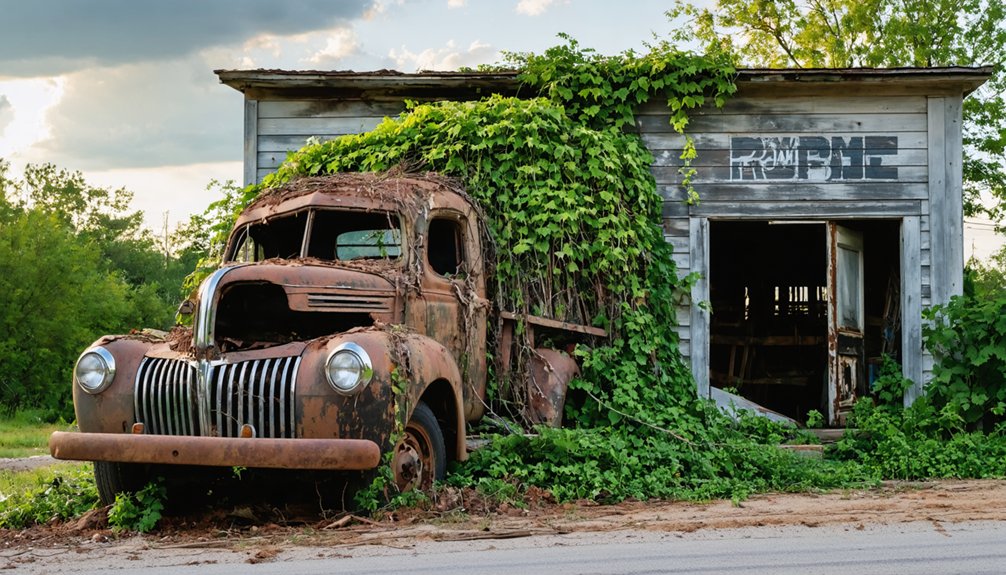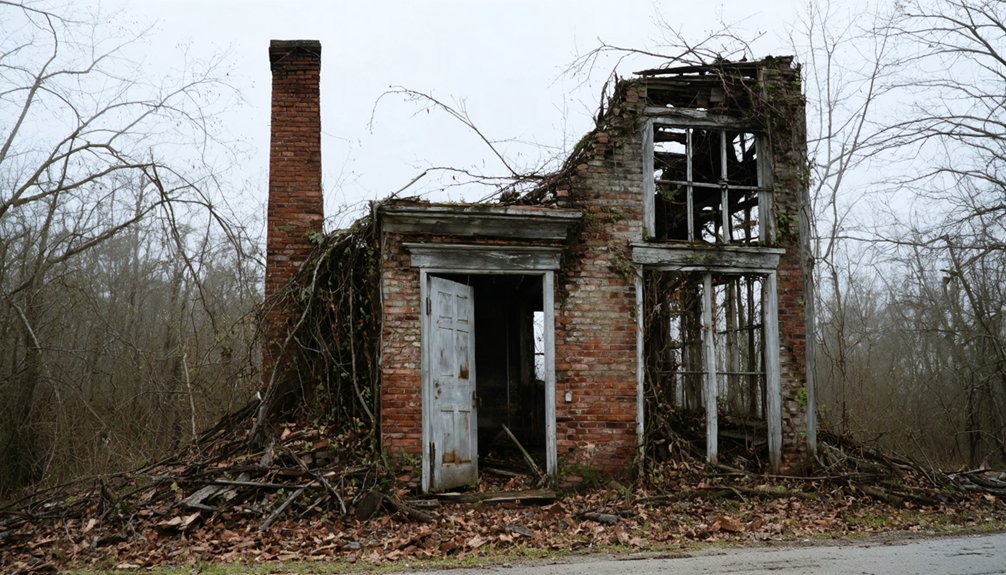You’ll find Turkey Town’s ruins along Alabama’s Coosa River, where Chief Little Turkey established the largest Cherokee settlement in the state between 1782 and 1788. This thriving Native American community, birthplace of future Cherokee leader John Ross, featured a council house and bustling trade networks. After the Trail of Tears forced removal in 1838, the town fell into decline, with its post office closing permanently in 1861. Today, Weiss Lake covers much of this historic site, though traces of its rich heritage remain.
Key Takeaways
- Turkey Town was established between 1782-1788 along Alabama’s Coosa River as the largest Cherokee settlement before becoming a ghost town.
- The town’s decline began after the 1838 forced removal of Cherokee people during the Trail of Tears.
- The post office’s permanent closure in 1861 marked the official end of Turkey Town as an active community.
- TVA projects in 1933 submerged portions of the former settlement beneath Weiss Lake, further erasing its physical presence.
- A marble monument now marks the location of the ghost town, commemorating Cherokee leaders Chief Little Turkey and John Ross.
Origins Under Chief Little Turkey
Between 1782 and 1788, Chief Little Turkey established Turkey Town along Alabama’s Coosa River near present-day Fitts Ferry in Etowah County. As the largest Cherokee settlement in Alabama, Turkey Town served as a crucial cultural refuge during a time of increasing hostilities with white settlers.
Turkey Town emerged as a vital Cherokee sanctuary on Alabama’s Coosa River, offering refuge as tensions with white settlers intensified.
You’ll find that this strategic location became central to Cherokee governance when Little Turkey was named the first Principal Chief of the Cherokee Nation in 1794.
The settlement’s importance grew rapidly with the establishment of a council house along Turkey Town Creek around 1789. Future Cherokee leader John Ross was born in Turkey Town on October 3, 1790.
The town’s influence extended across 25 miles along both banks of the Coosa River, where you’d have found a thriving community gathering at Ustinaire, their “Beloved town,” for Grand Councils that shaped the Cherokee nation’s future. Under Little Turkey’s leadership, John McDonald operated a trading post that supplied arms and munitions to the settlement.
Life Along the Coosa River
Along the Coosa River, you’ll find Turkey Town emerged as a critical hub where Cherokee traders established extensive networks, exchanging deerskins and other goods with both Native American tribes and European settlers.
The beautiful landscapes along the river created an ideal setting for the settlement. The river’s banks bustled with daily activities as Cherokee residents harvested fish, gathered medicinal plants, and maintained canoe landing sites for transport and trade. The 286-mile waterway provided a vital transportation corridor for the growing settlements.
You can trace how these riverside settlements fostered cultural exchange between the Cherokee and neighboring Muscogee (Creek) communities, while supporting essential trade routes that connected inland territories to coastal markets.
River Trade Networks
The Coosa River emerged as an essential economic artery long before European colonization, serving as the backbone of Native American trade networks through the powerful Coosa chiefdom in the 16th century.
You’ll find evidence of these trade routes in archaeological sites, where European goods mix with native artifacts, revealing complex patterns of economic exchange. Hernando de Soto first documented these extensive trading networks during his 1540 expedition through the region.
When you explore the river’s history, you’ll discover how British traders competed with French interests in the late 1700s, establishing critical connections with Muscogee Creek bands.
The river’s strategic importance grew as steamboats began carrying cotton and timber in the mid-1800s. The Gadsden Steamboat Co. established itself as a major commercial force in the region, transporting hundreds of cotton bales to Southern mills.
Towns like Ui-ukufki thrived as trading hubs, while settlers positioned their shops and blacksmith operations near the riverbanks to maximize access to both Native American communities and established trade networks.
Daily Riverbank Activities
When steamboats began dominating Coosa River traffic in 1845, daily life along the riverbank transformed into a bustling scene of commercial activity.
You’d find rolladores transferring cotton bales from riverside warehouses to steamboat landings, while enslaved firemen loaded wood to fuel the vessels’ boilers. The riverbank commerce centered around loading and unloading cargo, particularly cotton bound for Mobile. By the late 1930s, steamboat activity had largely disappeared as railroads became the dominant transportation method.
The riverbanks weren’t just for trade – they served as essential community gathering points. Today, the Coosa River Paddling Club continues this tradition of bringing people together along these historic waters.
You’d see enslaved ferrymen operating critical river crossings between settlements, while plantation life adapted to the river’s rhythms. The masters’ houses stood back from the shore, but the enslaved workers’ cabins were positioned near the water, facilitating their daily tasks and limited social interactions along the bustling riverfront.
Native American Heritage and Culture
Located along the fertile banks of the Coosa River, Turkeytown emerged in 1788 as a significant Cherokee settlement under the leadership of Chief Little Turkey, who’d become the first Principal Chief of the Cherokee Nation.
As you explore this historic site, you’ll discover how Cherokee traditions flourished here, with the town serving as a hub for cultural exchange between various Native American tribes.
The settlement’s cultural resilience shone through its role as both a refuge during the Cherokee-American wars and a diplomatic center.
You’ll find that Turkeytown hosted essential intertribal meetings, including the notable 1816 council that brought together Cherokees, Creeks, and Chickasaws.
The birthplace of John Ross in 1790, Turkeytown cultivated one of the most influential leaders in Cherokee history.
While much of the original site now lies beneath Weiss Lake, the town’s legacy endures as a monument to Cherokee heritage and diplomatic leadership.
Historical records show the area extended from Gadsden to Centre, spanning a significant portion of what is now Etowah County.
Fort Armstrong and Military Presence
Built in October 1813 during the Creek War, Fort Armstrong emerged as an essential military installation along the Coosa River near Turkeytown.
Under General James White’s direction, this stockade fort’s significance stemmed from its role as both a defensive stronghold and an important supply depot. You’ll find it particularly interesting that Cherokee soldiers exclusively manned the fort, demonstrating the strategic alliance between U.S. forces and Cherokee warriors during this conflict.
The fort’s military logistics played a critical role in supporting campaigns against hostile Red Stick Creeks, with supplies arriving via wagon trains from Fort Ross.
Though it operated briefly through 1814, Fort Armstrong’s impact on the war effort was substantial.
Today, you won’t find any physical remnants of the fort – it lies submerged beneath Weiss Lake’s waters.
Notable Residents and Leadership

Beyond the military fortifications, Turkeytown’s most enduring legacy stems from its remarkable leadership and notable residents. Chief Little Turkey established the settlement around 1770, creating a refuge during the Cherokee-American wars.
The leadership dynamics evolved through prominent figures like Chief Pathkiller, who led during the Creek War and served as Principal Chief.
You’ll find Turkeytown’s most famous native son was John Ross, born there in 1790 to Scottish trader Daniel Ross and his Cherokee wife. Ross later became Principal Chief of the Cherokee Nation, serving from 1828 to 1866.
Other notable figures included James Lasley, a wealthy entrepreneur who married into Cherokee families and maintained strong alliances with Chief Pathkiller and Major Ridge’s family.
These leaders shaped Turkeytown’s significance as a cultural and political center.
The Trail of Tears Impact
When the Indian Removal Act of 1830 took effect, Turkeytown became a pivotal site in one of America’s darkest chapters. U.S. Army troops and militias constructed stockades where they imprisoned approximately 16,000 Cherokee people before forcing them westward.
The removal consequences were devastating as soldiers tore families from their ancestral homes in the spring of 1838. Despite the Cherokee resilience, the military presence shattered the nation’s socio-political structure.
Eight companies of troops systematically rounded up residents, held them in deplorable conditions, and marched them along established routes including the northern path and Benge Route. The once-thriving community, led by Chief Little Turkey and connected to influential leader John Ross, saw its final days as its people began their tragic journey on the Trail of Tears.
Transformation Into a Ghost Town

After the forced Cherokee removal in 1838, Turkey Town’s once-bustling settlement rapidly deteriorated as homes were abandoned and economic activities ceased.
You’d find the town’s structures falling into disrepair while vegetation gradually reclaimed the land where Cherokee families had lived and worked for generations.
Nature’s forces steadily transformed the community into a ghost town, with the final marker of its demise occurring in 1861 when the post office closed its doors permanently.
Settlement Decline Post-Removal
Following the forced Cherokee removal in June 1838 under the Indian Removal Act, Turkey Town experienced a swift and irreversible decline into ghost town status.
The population shifts were catastrophic, as both Cherokee inhabitants and their affiliated settler families were uprooted, leaving behind a void that would never be filled.
The community disintegration manifested through multiple losses: the post office closed in 1861, military fortifications were abandoned, and civic infrastructure crumbled.
You’ll find that the town’s physical remnants faced further erasure when portions of the original site were submerged beneath Weiss Lake.
Without its Cherokee foundation and traditional land use patterns, Turkey Town couldn’t sustain itself.
The area’s transformation into a ghost town was sealed by the absence of any significant resettlement or population recovery.
Economic Activity Fades Away
The economic unraveling of Turkey Town paralleled its demographic collapse in the decades after Cherokee removal.
You’d have witnessed profound economic shifts as cotton farming’s profitability plummeted, trapping local farmers in cycles of debt. The area’s limited success with mining couldn’t compensate for agricultural decline.
When the TVA arrived in 1933, its projects brought both opportunity and disruption.
While dams provided electricity, they also submerged portions of Turkey Town’s original site and displaced farmers without compensation. The changing transportation patterns dealt another blow – the community that once thrived on river trade found itself bypassed by new rail routes.
These compounding factors accelerated rural depopulation as residents sought opportunities elsewhere, leaving Turkey Town’s economy to fade into memory.
Natural Elements Take Over
Once human activity dwindled in Turkey Town, nature swiftly reclaimed its domain across the 25-mile stretch along the Coosa River.
The process of natural reclamation transformed the abandoned settlement through ecological succession, as native forests and undergrowth steadily conquered former clearings and structures.
You’ll find nature’s takeover occurred in four dramatic ways:
- Creation of Weiss Lake submerged significant portions of the original site
- Native wildlife like deer and turkeys returned to establish new habitats
- Untamed vegetation penetrated and dismantled remaining buildings
- Seasonal floods reshaped the landscape through erosion and sediment deposits
Without human interference, the ghost town’s remnants continue dissolving into the wild southeastern landscape, where hardwoods and pines now stand sentinel over Turkey Town’s vanishing traces.
Archaeological Discoveries

Archaeological investigations at Turkeytown have yielded limited physical discoveries, largely due to the site’s submersion beneath modern lake waters.
While the exact location of Fort Turkeytown remains unclear, historical maps and records indicate a thriving Cherokee settlement once stretched 25 miles along the Coosa River, complete with a council house established by Chief Little Turkey.
Underwater exploration efforts have been challenged by environmental factors, yet researchers believe significant cultural resources lie preserved beneath the lake’s surface.
You’ll find that while direct archaeological evidence is sparse, the combination of historical documentation and advanced technology offers promising opportunities.
The site’s potential for revealing new insights into Cherokee life and cultural interactions remains high, despite the preservation challenges posed by its submerged state.
Present-Day Historical Significance
Despite being submerged beneath Weiss Lake’s waters, Turkeytown’s legacy endures as northeastern Alabama’s largest and most influential Cherokee settlement.
Today, you’ll find its cultural preservation manifested through various forms of historical tourism and local commemoration.
- A marble monument marks the prominent settlement area, serving as a tangible reminder of Chief Little Turkey’s founding and the birthplace of Principal Chief John Ross.
- The original Fort Armstrong site highlights Turkeytown’s military significance during the Creek War.
- Local events and publications continue to showcase the region’s Cherokee heritage and complex cultural interactions.
- Modern-day Turkey Town community, located about ten miles southwest of Centre, maintains the historical connection despite the original site’s submersion.
Frequently Asked Questions
What Crops Were Primarily Grown by Cherokee Farmers in Turkey Town?
Proudly practicing Cherokee agriculture, you’ll find they grew corn as their main crop, alongside beans and squash in the “Three Sisters” system, while tobacco and sunflowers diversified their crop selection.
How Did Turkey Town Residents Communicate With Other Cherokee Settlements?
You’ll find that Cherokee residents relied on verbal traditions, using messengers along established trails, while trade networks and kinship ties helped maintain essential communication links between settlements.
What Traditional Ceremonies and Rituals Were Practiced in Turkey Town?
Under towering oaks, you’d witness spiritual practices like the Green Corn Ceremony with sacred busk fires, seasonal powwows by the Coosa River, community gatherings for tribal councils, and nature-linked rituals honoring ancestors.
How Did Seasonal Flooding Affect Daily Life in the Settlement?
You’d face daily challenges as floods disrupted housing, farming, and travel. Settlement adaptation meant rebuilding structures, adjusting crop cycles, and creating flood prevention measures through elevated pathways and strategic food storage.
What Trading Relationships Existed Between Turkey Town and Neighboring Tribes?
You’ll find trade routes connecting Turkeytown to Creek and Chickasaw territories, where they exchanged deerskins, pottery, and European goods. Tribal alliances strengthened these networks through intermarriage and political agreements.
References
- https://en.wikipedia.org/wiki/Turkeytown_(Cherokee_town)
- https://en.wikipedia.org/wiki/Turkey_Town
- http://rickeybutchwalker.blogspot.com/2012/12/turkey-town.html
- https://gadsdenmessenger.com/fort-turkeytown-location-remains-an-etowah-mystery/
- https://turkeystown.com/2025/01/21/uncovering-the-history-of-turkeytown-traditional-location/
- https://storymaps.arcgis.com/stories/2bab1a955f714cb6a13c4e3d551d6804
- https://turkeystown.com
- https://www.blm.gov/blog/2021-04-19/turkeytown-alabama
- https://digitalalabama.com/alabama-history-with-melvin-cane/turkeytown-alabama/8736
- https://turkeystown.com/2025/04/02/the-beloved-chiefs-from-turkeytown-chief-little-turkey/



